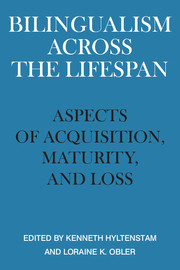Book contents
- Frontmatter
- Contents
- List of contributors
- Preface
- 1 Bilingualism across the lifespan: an introduction
- 2 Early differentiation of languages in bilingual children
- 3 Variation in children's ability to learn second languages
- 4 Idiomaticity as an indicator of second language proficiency
- 5 Prefabs, patterns and rules in interaction? Formulaic speech in adult learners' L2 Swedish
- 6 The imperfect conditional
- 7 Spanish, Japanese and Chinese speakers' acquisition of English relative clauses: new evidence for the headdirection parameter
- 8 Distinguishing language contact phenomena: evidence from Finnish–English bilingualism
- 9 The boustrophedal brain: laterality and dyslexia in bi-directional readers
- 10 Deterioration and creativity in childhood bilingualism
- 11 Crosslinguistic influence in language loss
- 12 Bilingualism in Alzheimer's dementia: two case studies
- 13 Language processing in the bilingual: evidence from language mixing
- Index
2 - Early differentiation of languages in bilingual children
Published online by Cambridge University Press: 05 June 2012
- Frontmatter
- Contents
- List of contributors
- Preface
- 1 Bilingualism across the lifespan: an introduction
- 2 Early differentiation of languages in bilingual children
- 3 Variation in children's ability to learn second languages
- 4 Idiomaticity as an indicator of second language proficiency
- 5 Prefabs, patterns and rules in interaction? Formulaic speech in adult learners' L2 Swedish
- 6 The imperfect conditional
- 7 Spanish, Japanese and Chinese speakers' acquisition of English relative clauses: new evidence for the headdirection parameter
- 8 Distinguishing language contact phenomena: evidence from Finnish–English bilingualism
- 9 The boustrophedal brain: laterality and dyslexia in bi-directional readers
- 10 Deterioration and creativity in childhood bilingualism
- 11 Crosslinguistic influence in language loss
- 12 Bilingualism in Alzheimer's dementia: two case studies
- 13 Language processing in the bilingual: evidence from language mixing
- Index
Summary
Introduction
The simultaneous acquisition of two (or more) “first languages” can be of particular interest for language acquisition studies. By analyzing the development of two linguistic competences in one individual, we may be capable of sorting out more easily to what extent the underlying logic of development is determined by the grammatical system to be acquired, or the particular way of human language processing as opposed to properties of the individual or of the communicative situation. There is, in fact, a steadily increasing amount of research in this area (see McLaughlin, 1984 or Taeschner, 1983 for fairly comprehensive overviews including more recent studies).
Much of this work is largely descriptive in its orientation, and theoretical questions are not always discussed explicitly. One question which is, however, pursued very frequently is whether bilinguals are able to “differentiate their two linguistic systems” (Lindholm and Padilla, 1978:334). (See, for example, Volterra and Taeschner, 1978, Redlinger and Park, 1980, and Vihman, 1982, 1985, and forthcoming, for some recent contributions to this discussion.)
The emerging picture is somewhat flawed by terminological confusions, especially with respect to those concepts underlying the terms “language mixing” and “code-switching”. To avoid problems of this kind, I will use code-switching to describe the bilingual's ability to select the language according to the interlocutor, the situational context, etc.
- Type
- Chapter
- Information
- Bilingualism across the LifespanAspects of Acquisition, Maturity and Loss, pp. 13 - 40Publisher: Cambridge University PressPrint publication year: 1989
- 199
- Cited by

